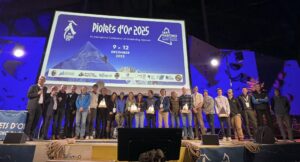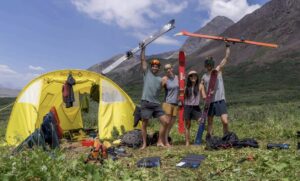In August, the most intense rains in over 60 years hit Pakistan. This prematurely ended many Karakoram expeditions and much of the climbing season. For those who continued to climb, conditions were complicated, with much snow at high altitude. September offered a few weather windows, but they were short. Climbers had to move fast if they wanted to exploit them. This is exactly what James Price of the UK did. It paid off but came with a toll too.

Price’s new route up Pheker Peak. Photo: James Price
Together with Pakistani Hassan Aljabbal and Adnan Khan, plus French filmmaker Sebastien Carniato, Price bagged this first ascent of Pheker Peak (5,465m) and the first traverse of Mirshikar Peak (5,464m) in the Karakoram. Yet he had a much more ambitious goal in mind: an all-or-nothing bet that nearly killed him.
Price contacted ExplorersWeb from a hospital in France, where he is recovering from the frostbite he suffered during his attempt to complete the first traverse of the Batura Wall, a 14km-long ridge along all the massif’s points.

Mirshikar Peak with Rakaposhi in the background.
The first part of the trip was swift and successful. The team left Kacheli village and climbed to the east col of Mirshikar via a steep snow gully. The following day, Price set off on his own, weaving a line through seracs on the north face of Pheker Peak, until he gained the northwest ridge and the summit.
A day later, the entire team scaled neighboring Mirshikar via the east ridge and bivouacked at the summit before descending the southwest ridge to complete the first traverse of this beautiful peak. Check a video about the ascent below:
Surviving the Batura Wall
Well-acclimatized and pumped by the success, Price headed for his ultimate goal — an absolute world first and, perhaps, a crazy idea. After opening routes in the range on Maidon Sar, Passu North, and Passu East in the summer of 2021, he returned to the area for a (much) longer and more ambitious trip.
He basically intended to complete a solo traverse of the entire Batura Wall, which stretches 40 to 50km, including 14 to 15km above 7,000m. It also features a nearly 4,000m drop to the valley floor on either side.
He went from the north, starting by Pasu East.
“The planned route would have included the peaks of Passu Sar, Muchu Chhish, and Batura VI before descending into the Muchuar Valley,” Price told Explorersweb. A technical ridgeline running 14km, all of it above 7,000m. No one has done or even attempted something like that.

James Price’s planned route across the Batura Wall. Photo: James Price
Among other obstacles, the third peak in Price’s plan was Muchu Chhish, the highest unclimbed peak for which it is possible to obtain a permit. A feat attempted by a few top teams and achieved by none. Moreover, teams have always tried Muchu Chhish from the opposite, southern side, and the opposite, western ridge. (Read about the previous attempts in the AAJ.)
“My goal, however, was not to climb Muchu Chhish,” Price said. “My dream was to traverse the Batura Wall, and Muchu Chhish just happens to be along the route.”

James Price on the Karakoram Highway, toward the Batura massif. Photo by Sebastien Carniato, courtesy of James Price
Price left the village of Passu on September 11, with 30kg of equipment on his back (including skis) and supplies for three weeks.
“The skis were really useful for the approach, especially going solo when you have to break trail by yourself,” he said. “They also add protection for crossing crevasses. The downside is that you have to carry them on your back on the technical sections.”
He headed up the Batura Glacier and Peak 5550m. From there, a complicated icefall leads to the upper Passu Glacier.
“Conditions were good, but in the night, 80cm of snow came down,” Price said. “It took a lot of energy the next day to reach the crest of the Batura Wall at 7,000m. That was where the games began.”

James Price with his carbon pole for crossing crevasses. Photo: James Price
He reached the summit of Passu East (Diar), then crossed to the north side and continued along the crest for another three kilometres to the summit of Passu Sar (7,470m).
“I arrived at the massive summit plateau in whiteout conditions and lost 90 minutes finding the narrow NW ridge toward Muchu Chhish and Batura. It was -28°C, too cold to stop. Fumbling with my GPS, I located the narrow ridge that leads down to east pass (6,900m) and then up to Muchu Chhish. No one had ever been here. I started tentatively down, but finding big cornices, I decided to retreat to the summit of Passu Sar to wait for better visibility and conditions. Just below the summit of Passu Sar, a collapsed cornice offered an almost perfect tent platform. Well protected from the bitter winds that lashed the summit, I waited here for 30 hours…waiting for a forecast…”
When the anticipated forecast finally came, it predicted snow and rain for the days ahead. Weakened by the cold and altitude, Price decided to retreat. He skied down to the base of Passu North in clear but windy weather and dug a platform beside a crevasse for the night.

Camp behind a serac. Photo: James Price
“When I removed my ski boots, I knew there was something wrong,” he told ExplorersWeb. “Cyanotically blue toes gleamed in the dark. My feet were rigid, stone cold to the touch. The signs were unmistakable. I tried to convince myself that it would be fine in the morning. I tucked them into the sleeping bag with a hot water bottle and tried to get some sleep.
“That night in the sleeping bag, alone at 6,800m, my toes started to defreeze. The pain was agonizing. I tossed and turned in the sleeping bag. I counted down the minutes till dawn. The snow started to come down and I drifted in and out of consciousness, caught between reality and a vivid dream world. I found myself surrounded by friends, then alone. The hours blurred into one another. Two days passed without me realizing it.”

Price in his tent, with first signs of frostbite.
When Price finally woke up, he had to dig his way out of the completely buried tent. Then he had to force his swollen feet back into the boots and set off again for what he described as a “mammoth task” — descending five vertical kilometres and then 70 horizontal kilometres to civilization.
At one point, I skied over a crevasse bridge and with a whomp, the bridge plunged into the abyss, leaving a gaping hole. That was close!
It took him two days to ski down, cross back over the icefall, climb up Peak 5550m, and retrace his steps downhill to the Batura Glacier and the village of Passu.
My feet were swollen. My toes blistered, mangled and hardly recognizable. It was a pitiful sight. Each time I set off, I’d give myself a target and force myself to walk until I reached it. I made good progress, but the minutes dragged by like hours.
It took two days to reach the Batura Glacier and another day to reach the roadside. Here, smiling from ear to ear, I met my good friends Seb and Salim. After 18 days on the mountain, words can’t describe what it meant to be with them.
They took me home and we partied into the night. The following day, after receiving some medical attention at the local clinic, I started the long journey home and was immediately hospitalized in France. I’m receiving treatment now for a few weeks, and then it’s home time.
The toll

Price in the hospital. Photo: James Price
He came home with severe frostbite on five toes. Price had surgery planned for today. He’ll have a clearer idea of the extent of the damage after that. Some parts will have to be amputated.
“It is what it is, I’ll have to recover and adapt and see the way to climb and run again — but I’m hopeful I’ll be back on the mountains soon,” Price said. He is 25 years old.
Looking back, one wonders about the risk that he took, especially venturing solo on such an ambitious goal. Was it even possible at all? Price retreated because of bad weather conditions, but would he have been able to complete the traverse otherwise?
“The route was as I expected,” Price said. “I had been on Passu East and Passu North last year, so I knew what to expect. As for going solo, risk management is very different from when you climb as a team. I have to adapt techniques usually done in pairs.”
Price mentioned, for instance, that he brought a four-metre carbon pole with him that he carried attached to his harness when crossing crevasses.
Looking ahead
He admits that one of the hardest aspects of this challenge was the cold in the Karakoram.
“That is a risk you always need to bear in mind, either climbing solo or in a team,” he said. “The level of risk taken when pushing your limits in these gigantic mountains is always going to be extremely high.”

James Price on the Batura ridge. Photo: James Price
He also admitted that for this route, he didn’t feel the need to do it solo. He would have been happy to share it with a partner who had the skills and motivation for such an ambitious goal.
“Will I try again? Well, it’s a beautiful, beautiful route — so in the right conditions, why not?” he said. “On this route, you don’t need an exceptional weather window. You just need to be acclimatized and ready, hanging around the area for a long time.”
James Price, 25, has climbed extensively in the Alps, where he has lived since 2020. He has completed the 82 4,000’ers and three of the big North Faces: the Eiger, Grandes Jorasses, and Matterhorn, which he soloed. He has also climbed in South America. This was his fourth visit to Pakistan. Last year, he made solo first ascents of Passu North (6,884m) and opened new routes on Passu Diar (7,295m) and Maidon Sar (6,090m).






